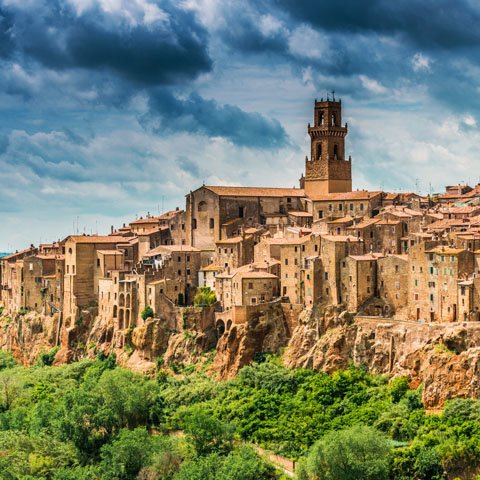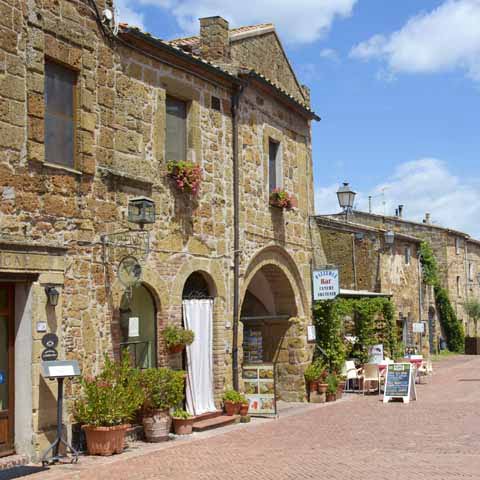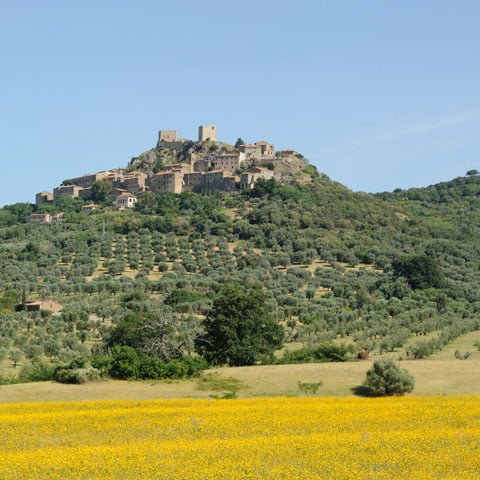Maremma is a vast geographical region located between the Lazio and Tuscany regions of Central Italy. It overlooks the Tyrrhenian Sea and, in addition to a central part corresponding to the province of Grosseto, it includes some coastal strips in the province of Livorno, known as Maremma Pisana.
Generally speaking, the territory is flat and alluvial, with a few hills scattered throughout.
Inhabited since the earliest times, Maremma is one of those places whose history spans millennia.
PREHISTORY OF MAREMMA
The first human traces in Maremma date back to the beginning of Lower Paleolithic. The first settlers were most likely hunters, occupying themselves with catching deer, wild ox, and donkeys. Survival was also assured by eating berries and other wild fruits, while the first dwellings were constituted by caves or other natural shelters.
The first traces of human presence in the territory belong to the so-called “amygdale” period from the Stone Age, and consist of two oblong “amygdales” carved in stone and datable to about three hundred thousand years ago.
Rich evidence of the Upper Paleolithic was also found in many caves around the entire territory of Maremma, and subsequently, the growth of human settlements is attested to during the Neolithic.
According to archaeological evidence, primitive populations established the first hut villages, increasing the population and diversifying the ways of subsistence by implementing trade, agriculture, and artisanal production.
Evidence also suggests that the first type of religion was linked to shamanism, as testified by some sepulchers excavated in the region.
With further development into a unifying proto-historic culture, Maremma holds evidence of the Villanovan culture, which was diffused all over Central and Northern Italy.
During the twelfth and tenth centuries BC, the territory also witnessed the organization of many fortified villages; remains from this period include weapons, buckles, brooches, as well as some bronze tools.
The Etruscans arrived in the area in the ninth century BC, when the local organization passed from tribal villages to fortified cities.
It is not clear how the Etruscans arrived, but traces of their passage can be found in many areas throughout the entire region.
During this period, the first division of the population into social classes was also observed; however, the Etruscans never reached a social unity, but remained divided into many autonomous cities that would follow different fates.
The decline of this civilization began in the fifth century BC, and reached its peak in the fourth century BC due to malaria.
Already weakened, the Etruscans now had to face the Romans who were in full process of expansion.
Between 298 and 280, the Romans conquered and turned most Etruscan cities into Roman municipalities.
The Roman conquest changed the layout of the territory. Most lands became public domain and were entrusted to wealthy Romans. The Etruscan colonies were replaced by estates run by slaves. The countryside was now depopulated, and those who managed to keep their lands started to migrate towards the hills, majorly motivated by the conditions of the coastal plains and the spread of malaria.
During this period, the Romans founded the ports of Certosa and Talamone, then continued with the construction of Via Aurelia.
In the first century BC, new settlements, villas, and roads started to rise along these roads, giving birth to new inhabited centers.
Undoubtedly, the region thrived under the Romans, but this prosperity became threatened by the events that led to the fall of the Western Roman Empire.
HISTORY OF MAREMMA
With the fall of the Western Roman Empire in 476, Maremma had a sudden administrative and economic decline that diminished notably after the conquest of the entire peninsula, in 554, by the Roman Emperor of the East, Justinian.
Under his rule, Orbetello became the main administrator of the area, ruling over all the cities in the Maremma region.
A few years later, in 569, the Nordic Lombards arrived in Italy overcoming the Alps, conquering the northern and central areas of the peninsula. As a result, Maremma again sank into a deep economic and administrative crisis.
During the period of the Lombard domination, the marshes advanced in most of the flat land, and the population moved to the hinterland, abandoning previous agricultural production, breeding, and trade.
The only documented trades of that period seem to be those of salt and wheat with the city of Lucca north of Maremma for about two centuries, and only much later did trade restart with some concessions for periodic markets such as Abbadia San Salvatore in 892 and to Istia d’Ombrone, from documents of 1032.
As in the rest of Italy, the Lombards were forced to retreat from Maremma in 774, after the defeat suffered by the Franks led by Charlemagne.
Maremma was divided, and the southern zone entered in the domains of the Church, which later made it the Lordship of the Abbey of Sant’Anastasio alle Acque Salvie, also known as Tre Fontane.
The north entered the Duchy of Tuscia governed by the Duke of Lucca, from which in 862 a feud arose entrusted to the Aldobrandeschi counts governed by the ancient city of Roselle.
Subsequently, the fiefdom was transformed into a hereditary county in 877 by the sovereign Carlo il Calvo. To better defend the territory from the incursions of the Saracens, the capital was moved inside to Sovana da Roselle, which began to decay maintaining however the bishopric seat until 1138, when it was transferred to Grosseto.
The economic, social and security conditions of the area favored the acquisition of land by small agricultural landowners and by powerful families or prelates in exchange for protection, which soon turned into local lordships with juridical, fiscal and armed powers.
Siena conquered Grosseto in 1222 and spread its dominion over the territory of the Aldobrandeschi who sought the alliance of the powerful Florence, granting in return the ports of Talamone and Porto Ercole.
Still, Siena managed to conquer the centers of Magliano, Montiano, Pereta, Collecchio, Istia d’Ombrone, and Campagnatico, after which the fortified town of Paganico was built in a magnificent strategic position to make it an important commercial center on the road to Siena.
The penetration of Siena in Maremma was not only military, but also political and commercial in nature. The power established agreements with the local potentates, purchasing lands, and limiting the possessions and influence of the Aldobrandeschi.
Slowly but steadily, Siena gained control over the entire region of Maremma, despite various struggles with the locals.
The middle of the fifteenth century found Siena ruling over the entire region, but its influence on the Maremma area favored its economic and commercial development. Indeed, new urban centers arose, while the cultural renaissance was also favored with the promotion of education.
With the capitulation of Siena to Florence in 1555, the territory became the domain of the powerful Medici lordship.
During Medici rule, Maremma underwent social, economic, and territorial changes, above all with the constitution of new large latifundia and the transfers of vast portions of lands to rich families that sacrificed agricultural production in favor of pastures for breeding and wheat monocultures.
The growth of the large estates impoverished the rural population and also other productive, artisanal and commercial activities, provoking new isolation of the territory.
However, the Medici greatly favored the urban and architectural growth of Grosseto, perhaps the only settlement in the region that flourished.
In 1765, Leopold of Lorraine became Grand Duke of Tuscany and began a great work of political, social, and economic reforms that also involved the territory of Maremma.
Indeed, Leopold was one of the most enlightened European rulers of the time, and some of his reforms included the abolition of the death penalty as well as other social policies that included the limiting of the estates and the favoring of agriculture.
The extremely poor rural population was for the first time favored. The liberalization of trade also contributed to lifting the territory of Maremma from its poor conditions.
From an administrative standpoint, Maremma remained separated from the territory of Siena with the constitution of the Lower Province, whose capital was in Grosseto. Once again, Grosetto was favored and expanded its borders beyond the city walls.
At the same time, the city received new infrastructure and institutional buildings, a hospital, and other edifices.
The renaissance of Maremma continued even after Leopold was proclaimed emperor of Austria in 1790.
His successor, Ferdinand III of Lorraine, continued the great works of reclamation of the marshes, and in 1796, Maremma, alongside the rest of the Tuscany, was occupied by Napoleon.
Soon after, in 1801, the Grand Duchy became the Kingdom of Etruria and was entrusted to the Spanish prince, Ludic I of Bourbon.
During the nineteenth century, the history of Maremma followed the fate of the entire Italian peninsula. In 1807, it was incorporated into the French Empire. Two years later, Napoleon restored the Grand Duchy, and the territory was returned to Ferdinand III of Lorraine in 1814.
In 1828, young Leopold II became Grand Duke, and he immediately revealed a liberal and tolerant character. Some of his innovations included new laws and provisions that brought Tuscany back into social enlightenment and cultural vocation.
Most of Maremma’s lands were returned and the area started to rebuild its new future based on agriculture, despite the fervent Risorgimento movements that were taking part all over Italy.
However, these reclamation works did not overcome all issues Maremma was facing. The problem of large landowner property left vast uncultivated lands, preventing small and productive owners from expanding too much.
Maremma was also poorly connected with the rest of the country, and the only railway line connecting Livorno to Civitavecchia was completed only in 1865.
With the Unification of Italy, the situation of Maremma worsened, and the only municipality to receive some benefits was Grosseto.
In the rest of the territory, the serious economic conditions had led to a dramatic impoverishment and social phenomena such as brigandage which, in southern Maremma included blackmail of landowners, theft of cattle, robberies, and violence.
In what was called Maremma banditry, some of these brigands became true popular heroes, such as Domenico Tiburzi, later killed by the Carabinieri in an ambush, for their activity against the great landowners.
Another local phenomenon due to the miserable conditions of the population was the birth of a religious revolt movement founded and led by Davide Lazzaretti in the Amiata area, hindered and severely repressed by a classist and authoritarian state.
During the two World Wars, Maremma lost even more from an economic standpoint. In the post-war era, the region reorganized itself, focusing majorly on agriculture, but also with a vision towards the tourism and service sectors.
Today, the region is one of the most renowned in Italy for its outstanding beauty.
ARCHAEOLOGY IN MAREMMA
Spanning over 1,900 square miles, Maremma boasts many archaeological areas. Among the oldest vestiges found in the territory, there are those of Lake Accesa, in the areas of Massa Marittima.
Surrounding the lake, traces of various inhabited centers and necropolises dating back to the seventh and sixth centuries BC have been found.
From the Etruscan Age, the necropolis and ruins near the area of Castiglione della Pescaia are perhaps the most significant.
Also belonging to the Etruscan age, the perimeter walls near the Roman city of Roselle at only a few miles from Grosseto show evidence of the advanced population that settled in the region.
In the same area, there is also important evidence of Roman passage, as shown by various remains of Roman dwellings, a Roman Forum, and a Roman amphitheater.
Also noteworthy is the necropolis of Sovana, an important archaeological area containing some monumental tombs.
The Archaeological Park of Baratti and Populonia situated on the slopes of Piombino overlooking the Gulf of Baratti, also holds traces of the Etruscan and Roman passage. The park preserves traces of a unique settlement built directly on the sea.
Don't just see Italy, live it.
Your dream trip to Italy has never been closer
No more endlessly scrolling travel sites. Our travel experts will craft the perfect, one-of-a-kind trip just for you.

300+
DESTINATIONS
We offer more Italian destinations than any travel site. Do and see more with Trips 2 Italy.
1 (of a kind)
ITINERARIES
Because your dream trip to Italy should be designed for you, not for the masses.
100%
PEACE OF MIND
From flights and accommodations, to food and activities - we take care of every detail.













